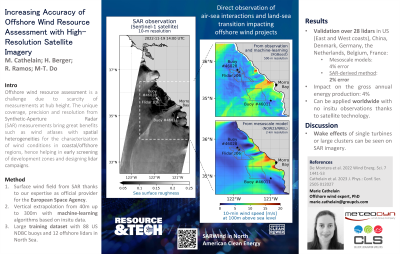Back

Increasing the Accuracy of Offshore Wind Resource Assessment with High-Resolution Satellite Imagery
Tuesday, October 1, 2024
5:00 PM – 6:00 PM MST
Location: Regency D


Minh-Thang DO, PhD
Technical Manager of Renewable Energy
Meteodyn
Bourne, Massachusetts
Poster Presenter(s)
Presentation Description: European synthetic-aperture radars (SAR) provide a 20-year database of high-resolution sea surface roughness observations over the globe. These observations are a direct reflection of governing atmospheric phenomena, especially air-sea and land-sea interactions that are not well captured by mesoscale modelling. Dedicated processing is needed to remove artefacts nonrelated to wind stress (e.g. ships, pollution, etc.) to retrieve geophysical quantities such as the surface wind speed. An advanced extrapolation algorithm based on machine learning techniques has been developed and trained with 12 lidars in the North Sea in order to provide wind speed at altitudes relevant for offshore wind applications. The extrapolation is validated over 28 lidars in Germany, the Netherlands, Belgium, France, US (East and West coasts), China. For instance, when comparing to short-term lidars measurements from 40 m to 200 m in South Brittany, France, the bias between extrapolated SAR wind speed and lidar measurements is very low (less than 0.1 m/s).
These unique coverage, precision and resolution from SAR measurements bring great benefits such as wind atlases with spatial heterogeneities for the characterization of wind conditions in coastal/offshore regions, hence helping in early screening of development zones and designing lidar campaigns. While the extrapolation methodology does not require any on-site measurements, we illustrate here the possibility to use on-site Lidar data to improve the accuracy of the SAR-based wind resource, therefore taking advantage of the accuracy of Lidar measurements and of the spatial distribution assessed by SAR. A new methodology to provide temporal and spatial MCP IEC-compliant products is under development.
These unique coverage, precision and resolution from SAR measurements bring great benefits such as wind atlases with spatial heterogeneities for the characterization of wind conditions in coastal/offshore regions, hence helping in early screening of development zones and designing lidar campaigns. While the extrapolation methodology does not require any on-site measurements, we illustrate here the possibility to use on-site Lidar data to improve the accuracy of the SAR-based wind resource, therefore taking advantage of the accuracy of Lidar measurements and of the spatial distribution assessed by SAR. A new methodology to provide temporal and spatial MCP IEC-compliant products is under development.
